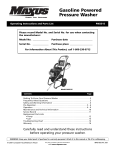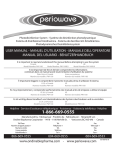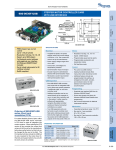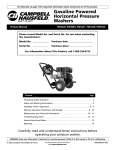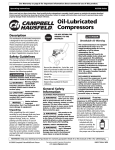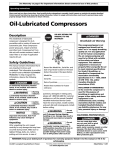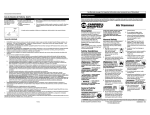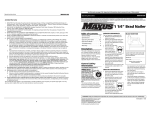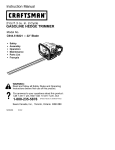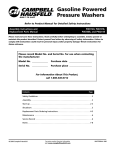Download Campbell Hausfeld Maxus IN469101AV Product manual
Transcript
See Warranty on page 14 for important information about commercial use of this product. Gasoline Powered Horizontal Pressure Washers BUILT TO LAST Product Manual PW2120, PW2420, PW2458, PW2705 Please record Model No. and Serial No. for use when contacting the manufacturer: Model No. ______________ Purchase date ____________________ Serial No. ______________ Purchase place ____________________ For Information About This Product, call 1-800-330-0712 Contents Page Frequently Asked Questions . . . . . . . . . . . . . . . . . . . . . . . . . . . . . . . . . . . . . . . . 2 Safety and Warning Information . . . . . . . . . . . . . . . . . . . . . . . . . . . . . . . . . . . . 3 Assembly and Pre-Operation . . . . . . . . . . . . . . . . . . . . . . . . . . . . . . . . . . . . . 4 - 5 Startup, Operation, Shutdown, and Storage . . . . . . . . . . . . . . . . . . . . . . . . 6 - 10 Maintenance and Technical Information . . . . . . . . . . . . . . . . . . . . . . . . . . 10 - 11 Troubleshooting Chart . . . . . . . . . . . . . . . . . . . . . . . . . . . . . . . . . . . . . . . 12 - 13 Service Record and Notes . . . . . . . . . . . . . . . . . . . . . . . . . . . . . . . . . . . . . . . . . 13 Warranty . . . . . . . . . . . . . . . . . . . . . . . . . . . . . . . . . . . . . . . . . . . . . . . . . . . . . . 14 Carefully read and understand these instructions before operating your pressure washer. REMINDER: Keep your dated proof of purchase for warranty purposes! Attach it to this manual or file it for safekeeping. © 2003 Campbell Hausfeld/Scott Fetzer For parts, product & service information visit www.chpower.com IN462400AV 8/03 Pressure Washers Frequently Asked Questions How do I start my pressure washer? 1. Make sure you have gas and oil in the engine. 2. Turn the water on, then trigger the gun to make sure the water will flow smoothly out of the nozzle or tip. 3. Put the engine throttle control in the “Fast/Start” position. Set the fuel shut off switch to “ON.” Set the on/off switch to “ON” (if applicable). 4. Set the choke to “ON.” 5. Pull the trigger (to relieve any back pressure in the pump) while pulling the starter cord. 6. If the engine does not start after three tries, repeat Step 5 (See Page 6) or see Troubleshooting Section (Pages 12-13). What type of oil do I use? The pump on the horizontal pressure washer comes filled with the correct amount of oil and should not need filling. See Page 11 for pump oil types and quantities. THE ENGINE DOES NOT COME FILLED WITH OIL. See Page 11 for engine oil types and quantities. Refer to Pages 10 and 11 of this manual and also refer to the included engine owner’s manual for oil changing instructions. Why don’t I have any water pressure? • Is the water hose attached to the pressure washer? • Is the water turned on? • Check for any kinks, leaks, or blockage in the hoses, fittings, or the nozzle. • Is the adjustable nozzle in the low psi position? If so, move it into the high psi position (See Page 8). • Is the inlet filter screen free of debris? Check and remove debris if needed. • Is the quick connect tip in place? (See Page 5.) How do I get high pressure? • For high pressure, move the nozzle into the high psi position (See Page 8). • For units with quick connect tips: use any color tip with the exception of black. Black tip is used for low pressure detergent application. How do I get the soap suction to work? 1. Connect the clear plastic chemical suction tube to the plastic hose barb on detergent tank (See Page 4). 2. Fill the detergent tank with detergent forumlated for use with pressure washers. 3. Move the nozzle into the low psi position (See Page 8). 4. For quick connect lance, use black detergent tip (See Page 8). Why doesn’t the pressure washer apply detergents with high pressure? The reason you don’t apply detergents with high pressure is because the detergents “bounce” off the cleaning surface as fast as you apply them. Detergent is only effective when you allow it time to work on the surface of whatever you are cleaning. You can only apply detergent at low pressure, wait 1-3 minutes to allow it to work, and rinse the surface with high pressure. What maintenance do I need to perform on my pressure washer? 1. After turning off the pressure washer and the water, depressurize the hose by triggering the gun. 2. Remove the garden hose and high pressure hose from the pump. 3. Pull the start rope slowly five times to purge water from the pump. This will help protect the pump from damage. 4. Do not store your pressure washer in an area where the temperature will drop below 32˚ F unless pressure washer is properly winterized (see Page 9). What do I do if I’m missing a part? Call Campbell Hausfeld at 1-800-330-0712 and we will promptly replace your missing parts. DO NOT RETURN THE PRESSURE WASHER TO THE RETAILER! Where can I buy accessories for my pressure washer? • If you can’t find accessories at the store where you purchased your pressure washer, call Campbell Hausfeld at 1-800-330-0712 or visit our website at www.chpower.com. Who do I call if I have questions or problems? Call Campbell Hausfeld at www.chpower.com 1-800-330-0712 (U.S.A.) 2 Safety and Warning Information Safety Guidelines This manual contains information that is very important to know and understand. This information is provided for SAFETY and to PREVENT EQUIPMENT PROBLEMS. To help recognize this information, observe the following symbols. Danger indicates an imminently hazardous situation which, if not avoided, WILL result in death or serious injury. ! DANGER Warning indicates a ! potentially hazardous situation which, if not avoided, COULD result in death or serious injury. 10. Follow the maintenance instructions specified in the manual. • Never permanently engage the trigger mechanism on the gun. Risk of injection or severe injury. Keep clear of nozzle. Do not discharge streams at persons. This product is to be used only by trained operators. Always remove lance from gun before cleaning debris from tip. • Never operate the machine without all components properly connected to the machine (handle, gun/wand assembly, nozzle, etc.). • Keep clear of nozzle. NEVER direct high pressure spray at a person, animal, or yourself. • • Always wear safety glasses or goggles and protective equipment (hearing protection, gloves, rubber boots, protective clothing) when operating or performing maintenance. ALWAYS turn water supply “ON” before turning pressure washer “ON.” Running pump dry causes serious damage. • Do not operate the pressure washer with the inlet water screen removed. Keep screen clear of debris and sediment. • NEVER operate pressure washer with broken or missing parts. Check equipment regularly and repair or replace worn or damaged parts immediately. ! WARNING WARNING Caution indicates a potentially hazardous situation which, if not avoided, MAY result in minor or moderate injury. ! CAUTION Notice indicates important information, that if not followed, may cause damage to equipment. NOTICE NOTE: Information that requires special attention. • Never try to stop or deflect leaks with any body part. • Always engage the trigger safety latch in the safe position when spraying is stopped even if only for a few moments. • Use only the nozzle supplied with this machine. Always follow detergent manufacturer’s label recommendations for proper use of detergents. Always protect eyes, skin, and respiratory system from detergent use. • Never leave the wand unattended while the machine is running. • Never tamper with the engine governor or attempt to alter factory settings. Altering factory settings could damage the unit and will void the warranty. • Always hold gun and wand firmly when starting and operating the machine. • NEVER allow the unit to run with the trigger released (off) for more than one minute. Resulting heat buildup will damage the pump. • NEVER store the pressure washer outdoors or where it could freeze. Freezing temperatures can seriously damage the pump. • Release the trigger when changing from high to low pressure modes. Failure to do so could result in damage to the nozzle. • When using this product, basic precautions should always be followed, including the following: 2. To reduce the risk of injury, close supervision is necessary when the product is used near children. 3. Follow all safety codes as well as the Occupational Safety and Health Act (OSHA). Do not use pres- ! WARNING sure that exceeds the operating pressure of any of the parts (hoses, fittings, etc.) in the pressurized system. Ensure all equipment and accessories are rated to withstand the maximum working pressure of the unit. ! WARNING • Explosion hazard. NEVER spray flammable liquids or use pressure washer in areas containing combustible dust, liquids, or vapors. 4. Ensure safety devices are operating properly before each use. DO NOT remove or modify any part of the gun or unit. • 5. Know how to stop this product and bleed pressure quickly. Be thoroughly familiar with the controls. NEVER operate this machine in a closed building or in or near an explosive environment. • Do not remove fuel tank cap or fill fuel tank while engine is hot or running (allow engine to cool two minutes before refueling). Always fill the tank slowly. 6. Stay alert – watch what you are doing. 7. Do not operate the product when fatigued or under the influence of alcohol or drugs. 8. Keep operation area clear of all persons. 9. Do not overreach or stand on unsta- Equipment damage. Never put hand or fingers over the spray tip while operating the unit. SAVE THESE INSTRUCTIONS 1. Read all instructions before using the product. NOTICE • Important Safety Instructions ! WARNING and water supply off, then press the gun trigger 2-3 times. ble support. Keep good footing and balance at all times. • Never disconnect the high pressure discharge hose from the machine while the system is pressurized. To depressurize machine, turn power 3 Keep hose away from sharp objects. Bursting hoses may cause injury. Examine hoses regularly and replace if damaged. Do not attempt to mend a damaged hose. ! CAUTION www.chpower.com Pressure Washers Pre-Operation UNPACKING Remove the equipment and all parts from the carton. The carton should contain the following. • One pressure washer (pump, engine, cart base). • One cart handle assembly. • One basket (not included with all models). • One front guard tube (not included with all models) • One detergent tank. • One spray gun. • One lance with nozzle. • Spray tips (not included with all models). • One high pressure hose. • One pack of nuts, bolts, and manuals. • One bottle of engine oil. If any parts are missing, DO NOT RETURN THE UNIT TO THE RETAILER. Know the unit’s model number (located on the serial number tag on the pressure washer frame) and call 1-800330-0712 for replacement parts. 2. An eyelet bolt is included with some models to secure the engine pull cord. Use this bolt and nut to secure the rear leg. Be sure to pull the starter cord through before tightening the bolt. See Figure 2. 6. If applicable: attach wire basket to front guard by pressing the hooks of the basket over the tube. Then align front eyelets of basket with front holes of front guard tube. Fasten with the 2 bolts, 4 washers, and 2 nuts provided (See Figure 5). Snap down over tube Fasten with bolts Figure 2 -Secure engine pull cord Figure 5 - Attach basket (if applicable) 3. Attach detergent tank to handle with the 4 hex bolts and 4 nuts provided. 4. Slide clear plastic hose attached to leg onto black plastic hose barb of detergent tank (See Figure 3). 7. Secure garden hose (not included) to the inlet connection on pump. (See Figure 6.) After unpacking the product, inspect it carefully for any damage that may have occurred during transit. Make sure to tighten fittings and bolts before using the pressure washer. Do not operate the unit if it’s damaged during shipping, handling, or use. Damage could result in bursting and cause injury or property damage. ! WARNING ASSEMBLY You will need 7/16” and 3/8” wrenches, and pliers, to assemble. 1. Slide the handle assembly over the lower legs of the cart base. Use the standard nut and bolt to secure the right rear leg. See Figure 1. Figure 6 - Secure garden hose Figure 3 - Attach suction tube to barb fitting 8. Connect the high pressure hose to the pump outlet (See Figures 7 and 8). 5. If applicable: attach front guard tube to base plate with the 4 bolts, 4 washers and 4 nuts provided (See Figure 4). Figure 7 - Connect high pressure hose to pump Fasten to baseplate Figure 4 - Attach front guard tube (if applicable) Figure 1 - Assemble Handle www.chpower.com 4 Pre-Operation (Continued) TRIGGER SAFETY LATCH Chemical injection hose In the engaged position, the trigger safety latch prevents the gun from being triggered accidentally. Push the latch fully down to engage it (See Figure 11). Always engage the trigger safety latch when the unit is not in use. Pressure adjustment knob Oil vent cap High pressure hose Outlet Trigger lock (not engaged) Garden hose Oil drain plug Inlet Thermal relief valve Figure 8 - Axial pump hookup 9. Attach the lance with nozzle to the gun (See Figure 9). Trigger lock (engaged) Figure 11 - Trigger lock ACCESSORY STORAGE Additional accessories can be stored in the back of the unit. Extra quick connect tips can be stored on the front upper area of the tank (See Figure 12). Figure 9 - Attach lance to gun 10. Install quick connect tip, if applicable (See Figure 10). Gun storage Accessory storage Figure 12 - Accessory storage Figure 10 - Quick Connect Tip 5 www.chpower.com Pressure Washers Operation 1. Surface Preparation a. If inlet water pressure is over 100 psi, install a regulating water valve at the garden hose connection. The following cleaning procedure will help you organize your cleaning task and ensures that you will achieve the best results in the shortest amount of time. Remember to use the spraying / cleaning techniques mentioned in the following section. NOTE: The inlet water supply must have a minimum flow rate of 5 gpm (19 lpm). Before starting a pressure washer cleaning job, prepare the surface you intend to clean. Clear furniture from the area and make sure that all windows and doors are closed tightly. Also, protect all plants and trees near the cleaning area with a drop cloth. A covering ensures that your plants won’t be sprayed by the detergents. 5. Trigger the gun until water sprays from the tip indicating that all air is purged from the system. Set the trigger safety latch. 2. Start Up ALWAYS use this start up procedure to ensure that the unit is started safely and properly. If water has frozen in the pressure washer, thaw the pressure washer in a warm room before starting. DO NOT pour hot water on or into the pump; internal parts will be damaged. NOTICE 1. Check engine oil levels. Add oil as necessary. NOTE: Some units are equipped with a low oil sensor that shuts the engine off if the oil level falls below a certain level. If the unit stops unexpectedly, check both the oil and fuel levels. Check the oil level each time you refuel the unit. 2. Check fuel level. DO NOT refuel a ! hot engine. Refueling a hot engine could cause a fire. Use only fresh, clean regular or unleaded gasoline. Close the fuel shutoff valve during refueling. WARNING 3. Attach a garden hose to the inlet side of the pump and connect it to the water supply. Use a hose with an I.D. of 5/8” and a length of 50 ft. (15 m) or less. Some local plumbing codes require backflow prevention when connecting to a fresh water supply. Install a backflow preventer upstream from the pump if necessary. NOTICE b. Do not exceed 100˚ F (38˚ C) inlet water temperature. 4. Turn the water supply ON. Never run the unit dry. Be sure the water supply is completely turned on before operating the unit. NOTICE 6. a. Honda Engines: Open the fuel shutoff valve by turning the knob counterclockwise until it stops. Close the choke (if engine is cold) by moving the choke lever fully to the right. Move the throttle, if equipped, fully to the right to the Run or Rabbit position. b. Briggs and Stratton Engines: Push the primer bulb three or four times (if equipped). Close the choke (if engine is cold) by moving the choke lever fully to the left. Move the throttle fully to the left to the Run or Rabbit position. c. Robin Engines: Open the fuel shutoff valve by turning the lever to the downward position. Close the choke (if the engine is cold) by moving the choke lever fully to the left. Move the throttle fully to the left to the Run or Rabbit position. When pulling the starter rope, make sure to keep your hand and arm clear of the engine and cart components. ! CAUTION Never let the starter rope return by itself. Doing so could jam the recoil system. NOTICE 8. If the engine does not start after two or three pulls or if the rope is hard to pull, squeeze the gun trigger to release the pressure that has built up in the high pressure hose. Repeat Steps 7 and 8 until the engine starts. 3. Initial High Pressure Rinse After the engine starts, trigger the gun 3 to 5 times to get any trapped air out of the system. After the spray becomes constant, you may need to adjust the pressure or the spray fan angle for the optimal cleaning performance needed (see pages 7, 8 and 9 for cleaning techniques). PRESSURE ADJUSTMENT Some units have a pressure adjustment knob located on the pump (see Figure 13). Turn the knob clockwise to increase the pressure. Turn the knob counter clockwise to decrease the pressure. Do not try and force the knob to turn. The knob may already be at either the lowest or highest setting. 7. Start the engine. If the engine is cold, completely close the engine choke. If the engine is warm, leave the choke open or just partially closed. Unlock the trigger safety latch on the gun. Grasp the starter rope and brace one foot on the chassis. While squeezing the trigger on the gun, pull the starter rope rapidly and firmly. Continue holding the rope as it returns. Repeat these steps until the engine starts. In cool weather, the choke may have to be kept closed for 10 to 30 seconds to keep the engine running. Otherwise, open the choke as soon as the engine starts. www.chpower.com 6 Figure 13 - Axial pump pressure adjustment If there is not a plastic adjustment knob located on the pump (See Figure 13), then the pressure cannot be adjusted. The only way to adjust the pressure is to move closer or further away from the cleaning surface and adjust the spray fan angle as shown in the next section. Operation (Continued) ADJUSTING THE SPRAY FAN ANGLE Your unit is either equipped with a adjustable fan nozzle or quick connect tips that have a range of spray fan angles. If equipped with the adjustable fan nozzle, the spray end of the lance can be rotated to have a 0o narrow high impact stream to a 60o wide fan spray (See Figure 14). A narrow stream has high impact force on the cleaning surface and results in maximum deep cleaning in a concentrated area. However, this narrow high impact spray can damage some surfaces, so use it cautiously. A wide fan pattern will distribute the impact of the water over a larger area resulting in excellent cleaning action with reduced risk of surface damage. Clean large surface areas quickly using a wide fan pattern. Figure 18 - Optimum angle to cleaning surface Nozzle Figure 14 - Adjusting nozzle for fan pattern Figure 16 - Narrow high impact stream If equipped with the quick connect tips, the tips can be switched out from a 0o narrow high impact stream to a 65o wide fan spray. Quick connect tip Figure 17 - Wide fan pattern Pull back collar Quick connect tip Figure 15 - Installing Quick Connect Tip The color of the tip shows what spray angle it is: Red – 0o – Maximum Duty ANGLE TO THE CLEANING SURFACE When spraying water against a surface, you can generate maximum impact by striking the surface head on. However, this type of impact can cause dirt particles to embed in the surface and can prevent the desired cleaning action. The optimum angle for spraying water against a cleaning surface is 45 degrees. Spray water against a surface at a 45 degree angle to achieve the most beneficial impact force and to efficiently remove debris. Yellow – 15o – Heavy Duty Green – 25o – General Duty White – 40o – Light Duty Black – 65o – Low Pressure Detergent 7 DISTANCE FROM CLEANING SURFACE The distance between the spray nozzle and the cleaning surface is another factor that affects the impact force of the water. The impact force of the water increases as the nozzle is moved closer to the surface. HOW TO AVOID DAMAGING SURFACES Damage to cleaning surfaces occurs because the impact force of the water exceeds the durability of the surface. You can vary the impact force by controlling the nozzle’s fan pattern, the nozzle’s angle to the cleaning surface, and the nozzle’s distance from the cleaning surface. Never use a narrow high impact stream or a Turbo/rotary nozzle on a surface that is susceptible to damage. Avoid spraying windows with a narrow high impact stream or turbo nozzle. Doing so may break the window. The most sure way to avoid damaging surfaces is to follow these steps: 1. Before triggering the gun, adjust the nozzle or quick connect tip to a wide fan pattern. 2. Place the nozzle approximately 4-5 feet away from the cleaning surface. Then hold the nozzle at a 45 degree angle to the cleaning surface. Trigger the gun. 3. Vary the fan pattern spray angle and the distance to the cleaning surface until optimum cleaning efficiency is achieved without damaging the surface. www.chpower.com Pressure Washers Operation (Continued) TURBO NOZZLE (NOT INCLUDED WITH ALL MODELS) A turbo nozzle, sometimes referred to as a rotary nozzle, can significantly reduce cleaning time. The turbo nozzle combines the power of a narrow high impact stream with the efficiency of a 25 degree fan pattern. The turbo nozzle swirls a narrow high impact stream into a cone shape to clean a larger area. Since a turbo nozzle uses a narrow high impact stream, only use a turbo lance in applications where the cleaning surface cannot be damaged by narrow high impact spray. The turbo nozzle is NOT adjustable and cannot be used to apply detergent. NOTICE 4. Detergent Application USE THE INSTRUCTIONS APPROPRIATE FOR MODEL PURCHASED NOTE: Use only detergents formulated for pressure washers. NOTE: Test detergent in an inconspicuous area before use. Never slide the nozzle from low to high pressure or from high to low pressure when the gun is triggered. NOTICE stains, use a brush in combination with detergents and high pressure rinsing. B. MODELS WITHOUT DETERGENT TANKS A. MODELS WITH DETERGENT TANKS Some gasoline powered units are not equipped with detergent tanks. Some gasoline powered units are equipped with detergent tanks. If your unit has a detergent tank: If your unit does not have a detergent tank: 1. Follow manufacturer’s label directions for mixing correct concentrations of soap/detergents. The soap detergent to water ratio through the pump is approximately 10% (1 to 10). 1. Follow manufacturer’s label directions for mixing correct concentrations of soap/detergents. The soap detergent to water ratio through the pump is approximately 10% (1 to 10). 2. Pour detergent into the detergent tank. The tank capacity is 1.5 gallons. 2. Insert the filter end of the clear plastic detergent tube into the detergent container. 3a. Place hand around the 3.5” spraying end section of the lance (the section that turns from left to right). Pull firmly and quickly away from you. (NOTE: Do not adjust lance while spraying.) The lance will extend 1/2” and be in low pressure (see Figure 20). Soap can only be drawn in low pressure. 3a. Place hand around the 3.5” spraying end section of the lance (the section that turns from left to right). Pull firmly and quickly away from you. (NOTE: Do not adjust lance while spraying.) The lance will extend 1/2” and be in low pressure (See Figure 20). Soap can only be drawn in low pressure. 3b. For units with quick connect tips: use the black 65o quick connect spray tip (See Figure 19). 3b. For units with quick connect tips: use the black 65o quick connect spray tip (see Figure 19). GENERAL CLEANING TIPS 1. Apply the detergent so that it thoroughly covers the cleaning surface. Apply the detergent from bottom to top to prevent the detergent from sliding down and streaking. Wait a couple of minutes for the detergent to break down the dirt and grime. Use a brush to lightly scrub heavily Never replace quick ! WARNING connect tip when gun is triggered. DETERGENTS The use of detergents can dramatically reduce cleaning time and assist in the removal of difficult stains. Many detergents are customized for pressure washer use on specific cleaning tasks. Pressure washer detergents are as thick as water. Using thicker detergents – like dish soap – will clog the chemical injection system and prevent the application of the detergent. Once applied to a cleaning surface, detergents take time to break down dirt and grime. Detergents work best when applied at low pressure. You can effectively clean surfaces by combining the chemical action of detergents with high pressure rinses. On vertical surfaces, apply the detergent starting at the bottom and work your way upward. This method prevents the detergent from sliding down and causing streaks. Begin high pressure rinsing at the bottom and work your way upward. On particularly tough www.chpower.com Figure 19 - Quick Connect Tip Low Pressure Nozzle High Pressure Figure 20 - Adjusting nozzle for pressure 8 Operation (Continued) soiled areas. Never allow the detergent to dry on the cleaning surface. 2a. To rinse or to return the nozzle to high pressure, release the trigger and slide the nozzle to the high pressure setting. 2b.For units with quick connect tips: replace black 65o tip with another color tip. Never make the nozzle pressure adjustment when the gun is triggered. Adjusting the high-low nozzle when the gun is triggered can result in damage to the seals in the nozzle. NOTICE ! WARNING Never replace quick connect tip when gun is triggered. 3. After using detergents, flush the suction system by placing the detergent suction tube into a bucket of clean water or rinse out tank. 7. Shutdown 1. Be sure all detergent is flushed from system. 2. Turn the engine OFF. 3 Turn the water supply OFF. 4. After the engine and water supply are turned off, trigger the gun to depressurize the system. NEVER turn the water supply off before turning the engine/motor off. Serious damage could occur to the pump and/or engine/motor. NOTICE NEVER disconnect the high pressure discharge hose from the machine while the system is pressurized. To depressurize, turn engine/motor off, turn water supply off and squeeze gun trigger 2-3 times. ! CAUTION 5. After each use, wipe all surfaces of the pressure washer with a clean, damp cloth. 5. Cleaning Power • Do not store the pressure washer outdoors. You can control the cleaning power of your pressure washer in two ways: • Do not store the pressure washer where it might freeze unless it has been properly winterized (see page 9, third column). 1. Adjust the spray pattern at the nozzle. Choose the widest pattern possible for spraying when starting the job and adjust the pattern to a narrower angle until you find a suitable pattern. 2. The easiest way to regulate the cleaning power of your pressure washer is by changing the distance from the surface you are cleaning. Begin spraying with a wide fan pattern while standing several feet from the surface. Slowly move closer to the object you are cleaning, adjusting the spray pattern as necessary, until you find the most effective cleaning technique. NOTE: Some units also may have a regulator knob on the pump that can adjust the pressure (if so equipped). 8. Storage LONG TERM STORAGE INSTRUCTIONS (MORE THAN 30 DAYS IN STORAGE) 1. Remove fuel from the tank and run the pressure washer in a normal operating mode until the engine stops from a lack of fuel. Normal operating mode means actually spraying water from the gun while the engine is running. Alternate method – Add fuel stabilizer to gas in the tank and run in normal operating mode for at least five minutes. 2. Stop the engine, turn off the water supply, and trigger the gun to release pressure in the high-pressure hose. PRESSURE RELIEF PROCEDURE To reduce the risk of bodily injury or property damage, always follow this procedure whenever spraying is stopped, when work is completed, and before checking or repairing any part of the system. 1. Engage the trigger safety latch. 2. Turn the unit off. 3. Remove the ignition cable from the spark plug. 4. Shut off the water supply. 5. Disengage the trigger safety latch and trigger the gun to relieve pressure. 6. Re-engage the trigger safety latch. 7. Before overnight storage, long term storage, or transporting unit, disconnect the water supply and turn off the fuel supply valve. Never pull the starter rope on the engine when the spark plug is removed unless the spark plug hole is covered. Fuel vapor from the hole can ignite by a spark. ! WARNING 7. Place a rag over the spark plug hole and slowly pull the starter rope several times to distribute the oil. WINTERIZING INSTRUCTIONS 1. Follow and complete the Long Term Storage Instructions on Page 9. 2. Disconnect the spark plug wire. 3. Disconnect the high pressure hose from the pump. 4. Insert a 12” to 14” piece of garden hose into the pump inlet. 5. Place a funnel in the other end of the garden hose. 6. Final Rinse 3. Disconnect the water supply and high pressure hose from the pump. The final rinse should start at the bottom and work upward. Make sure that you thoroughly rinse the surface and that you remove all detergent. 4. Allow the engine to cool. Read the manufacturer’s instructions for safe handling and disposal of RV antifreeze. 5. Disconnect the spark plug wire and remove the spark plug. 6. Pour approximately 6 oz. of RV antifreeze into the funnel. NOTICE 6. Pour 1/2 oz. of engine oil into the spark plug hole. www.chpower.com 9 Pressure Washers Operation (Continued) 7. Pull the starter rope several times until the RV antifreeze comes out of the pump outlet. TIPS FOR EXTENDING THE LIFE OF YOUR PRESSURE WASHER 8. Disconnect the high pressure hose from the gun and drain the hose. Hold the gun and lance in a vertical position and squeeze the trigger to drain the water out. 2. Your pressure washer is not meant to pump hot water. Never connect your pressure washer to a hot water supply as it will significantly reduce the life of the pump. 1. Never operate the unit without water. 3. Running the unit for more than one minute without spraying water causes heat to build up in the pump. Running the unit without spraying water can damage pump components. 4. Release the trigger prior to switching the lance between high and low pressure. Failure to do so may reduce the life of the o-rings in the lance. Maintenance Observe regular maintenance intervals to ensure maximum performance and life from the pressure washer. Refer to the schedule for recommended maintenance. If you operate the pressure washer in dusty conditions, perform maintenance checks more often. ENGINE OIL CHANGING INSTRUCTIONS Before tipping the engine or equipment to drain oil, drain fuel from the fuel tank. ! CAUTION NOTE: Change oil while the engine is cool. 1. Disconnect the spark plug wire from the spark plug. 2. Locate and remove the engine oil drain plug (see Figure 21). 3. Drain old oil. 4. Replace the drain plug and set the unit upright. 5. Refill the unit with new oil of a recommended type and quantity. Fill the unit to the proper level shown on the dipstick (if provided). Otherwise, fill the unit to the top of the oil filler neck. Oil drain Plug on either side of engine base Figure 21 - Oil Drain Locations (also see Figure 22) Oil fill Figure 22 - Oil drain and fill locations www.chpower.com 10 Maintenance (Continued) CHECKING PUMP OIL AND PUMP OIL CHANGING NOTE: The oil in the pump is a special synthetic type and must only be replaced by the exact same type. See the pump parts lists for the type of oil to order. Some pumps have an oil sight glass to check the pump oil level. The oil level should be at about the middle of the sight glass. It may be difficult to see the oil, so tilting the unit some may help to find the level line of the oil. Maintenance Schedule Maintenance Schedule Daily • Check water inlet screen and filter. • Check engine oil levels. Fill as necessary. • Check gasoline level. Fill as necessary. After first 5 hours of operation • Change engine break-in oil. Use SAE30 or 10W30 detergent oil. Every 25 hours of operation • Change oil if operating under heavy load or high ambient temperature. • Remove and clean foam pre-cleaner or foam air filter (if applicable). Wash with water and mild detergent. Dry thoroughly. Rub with oil and squeeze to distribute oil. Every 50 hours of operation • Change oil. • Replace spark plug. Each 100 hours of operation or every 3 months • Clean or replace paper air cleaner cartridge. Tap gently to remove dirt. • Change engine oil. If the pump does not have a sight glass, then the oil level cannot be checked. Normally, it is not necessary to change the oil in the pump. If there is a noticeable amount of oil that is leaking from the pump, then the oil seals may be worn or damaged and the unit should be taken to an authorized Campbell Hausfeld Service Center for repair. Action needed Technical and Consumer Information Horizontal Oriented Pressure Washers Engine Oil Type SAE 10W-30 SAE 30W (Above 60˚ F) Engine Oil Capacity Briggs and Stratton engines Honda engines Robin engines 20 fl. oz. 18 fl. oz. 20 fl. oz. Engine Fuel Capacity Briggs and Stratton engines Honda engines Robin engines 0.75 gal 0.46 gal 0.95 gal Pump Oil Type Horizontal axial pumps Special. See Parts List. Pump Oil Capacity Horizontal axial pumps 4.5 fl. oz. Pump Detergent Suction Water to detergent ratio 10 to 1 (10% detergent) Water Supply Requirements Minimum inlet pressure Maximum inlet pressure Maximum inlet temperature Minimum inlet flow rate Inlet garden hose size Maximum inlet garden hose length 11 20 psi 100 psi 100˚ F 5 gpm 5/8” I.D. 50 ft www.chpower.com Pressure Washers Troubleshooting Chart - Gasoline Powered Pressure Washers Only Symptom Possible Cause(s) Corrective Action(s) Engine will not start or is hard to start 1. No gasoline in fuel tank or carburetor 1. 2. 3. 4. Low oil Start/Stop switch in stop position Water in gasoline or old fuel 2. 3. 4. 5. 6. 7. 8. Dirty air cleaner filter Spark plug dirty, wrong gap or wrong type Spray gun closed Other causes 5. 6. 7. 8. Fill the tank with gasoline,open fuel shut off valve. Check fuel line and carburetor Check oil level. Fill if necessary Move switch to start position Drain fuel tank and carburetor. Use new fuel and dry spark plug Remove and clean or replace Clean, adjust the gap, or replace Trigger spray gun See engine owner’s manual Engine misses or lacks power 1. 2. Partially plugged air cleaner filter Spark plug dirty, wrong gap or wrong type 1. 2. Remove and clean or replace Clean, adjust the gap, or replace Low pressure and/or pump runs rough 1. 2. 3. 4. 5. Worn or wrong size tip Inlet filter on pump clogged Worn water seals, abrasives in water, or natural wear Fouled or dirty inlet or discharge valves Restricted inlet 1. 2. 3. 4. 5. 6. 7. 8. 9. Worn inlet or discharge valves Leaking high pressure hose Pump drawing in air Unloader valve seat faulty or worn 6. 7. 8. 9. Replace with tip of proper size Clean. Check more frequently Check filter. Replace water seals. See service center Clean inlet and discharge valve assemblies. Check filter Check garden hose, may be collapsed or kinked. Check inlet water flow Replace worn valves Replace high pressure hose Ensure hoses and fittings are tight Check and replace Water leakage from under pump manifold Worn water seals Install new water seals. See service center Water in pump crankcase (milky oil) 1. 2. 3. Humid air condensing inside crankcase Oil seals leaking Water seals leaking 1. 2. 3. Change oil as specified in maintenance schedule Install new oil seals. See service center Install new water seals. See service center Frequent or premature failure of the pump water seals 1. 2. 3. 4. 5. Scored damaged or worn plungers Abrasive material in the fluid Inlet water temperature too high Overpressurizing pump Excessive pressure due to partially plugged or damaged tip Pump running too long without spraying Pump running dry 1. 2. 3. 4. 5. Install new plungers. See service center Install proper filtration on pump inlet plumbing Check water temperature; may not exceed 100o F. Do not modify any factory set adjustments. Clean or replace tip. 6. 7. Never run pump more than 2 minutes without spraying Do not run pump without water 6. 7. Strong surging at the inlet and low pressure Foreign particles in the inlet or discharge valve or worn inlet and/or discharge valves Clean or replace valves. See service center Oil leakage between the engine and the pump Worn oil seals and/or o-ring Replace oil seals and/or o-ring. See service center Fluctuating pressure 1. 2. 3. Low engine oil Valve worn, dirty or stuck Pump drawing in air 1. 2. 3. 4. Tip clogged 4. Add oil. Check and replace Ensure hoses and fittings are tight. Purge air from garden hose Check or replace Pressure drops after period of normal use 1. 2. 3. 4. 5. Worn pump water seals Nozzle worn Valve worn, dirty or stuck Unloader valve seat worn or dirty Nozzle in low PSI position 1. 2. 3. 4. 5. Check and replace Check and replace Check, clean or replace Check, clean or replace Pull back nozzle to high pressure position Pump noisy / pump runs rough 1. 2. 3. 4. Pump drawing in air/low water supply Valves dirty or worn Worn bearings Water too hot 1. 2. 3. 4. Ensure fittings are tight. Increase water pressure Check, clean or replace Check and replace Reduce temperature below 100o F CONTINUED ON NEXT PAGE www.chpower.com 12 Troubleshooting Chart - Gasoline Powered Pressure Washers Only Symptom Possible Cause(s) Corrective Action(s) Pressure washer will not spray detergent 1. 2. 3. Nozzle not pushed up far enough Clog, kink, or hole in detergent suction hose Hose length too long 1. 2. 3. 4. Lance not functioning properly 4. 5. Not using quick connect detergent tip 5. Push nozzle forward as far as it will go. If clean, unkink or replace hose. Use only hose length provided with initial purchase of pressure washer. Detergent suction will not function if more than once section of hose is attached to unit. Remove lance from gun. If detergent is dispensed through gun, the lance must be replaced. If not detergent is dispensed through gun, remove 1” tapered detergent barb from pump. Clean the barb, and make sure that ball and spring are properly aligned with tapered portion of the spring facing the ball. The ball should be on top of the spring. Use black quick connect detergent tip. Service Record Date Replacement components required Maintenance performed Notes www.chpower.com 13 Pressure Washers Limited Warranty 1. DURATION: From the date of purchase by the original purchaser as follows: Standard Duty - One Year, Serious Duty - Two Years, Extreme Duty - Three Years, Maxus Brand Serious Duty - Three Years, Maxus Brand Extreme Duty - Five Years. 2. WHO GIVES THIS WARRANTY (WARRANTOR): Campbell Hausfeld / Scott Fetzer Company, 100 Production Drive, Harrison, Ohio, 45030, Telephone: (800) 330-0712 3. WHO RECEIVES THIS WARRANTY (PURCHASER): The original purchaser (other than for purposes of resale) of the Campbell Hausfeld pressure washer. 4. WHAT PRODUCTS ARE COVERED UNDER THIS WARRANTY: Any Campbell Hausfeld Pressure Washer supplied or manufactured by the Warrantor. 5. WHAT IS COVERED UNDER THIS WARRANTY: Substantial defects on material and workmanship which occur within the duration of the warranty period with the exceptions noted below. 6. WHAT IS NOT COVERED UNDER THIS WARRANTY: A. Implied warranties, including those of merchantability and FITNESS FOR A PARTICULAR PURPOSE ARE LIMITED FROM THE DATE OF ORIGINAL PURCHASE AS STATED IN THE DURATION. If this pressure washer is used for commercial, industrial or rental purposes, the warranty will apply for ninety (90) days from the date of purchase. Some States do not allow limitation on how long an implied warranty lasts, so the above limitations may not apply to you. B. ANY INCIDENTAL, INDIRECT, OR CONSEQUENTIAL LOSS, DAMAGE, OR EXPENSE THAT MAY RESULT FROM ANY DEFECT, FAILURE, OR MALFUNCTION OF THE CAMPBELL HAUSFELD PRESSURE WASHER. Some States do not allow the exclusion or limitation of incidental or consequential damages, so the above limitation or exclusion may not apply to you. C. Any failure that results from shipping damage, accident, purchaser’s abuse, neglect or failure to install and operate pressure washer in accordance with instructions provided in the owner’s manual(s) supplied with product. D. Pre-delivery service, i.e. assembly, oil or lubricants and adjustment. E. Items or service normally required to maintain the pressure washer. F. Gasoline engine and components are expressly excluded from coverage under this limited warranty. Such components should be returned by the purchaser to the original manufacturer or to its authorized repair stations for service. G. Additional items not covered under the warranty: 1. Normal wear items such as high pressure hoses, water and oil seals, o-rings, valves, lances and spray tips. 2. Motor brushes (Electric models only). 3. Cosmetic defects that do not interfere with functionality. 4. Rusted components. 5. Pump wear or valve damage caused by using improper oil, oil contamination or by failure to follow proper oil maintenance guidelines. 7. RESPONSIBILITIES OF WARRANTOR UNDER THIS WARRANTY: Repair or replace, at Warrantor’s option, pressure washer or component which is defective, has malfunctioned and/or failed to conform within duration of the warranty period. 8. RESPONSIBILITIES OF PURCHASER UNDER THIS WARRANTY: A. Provide dated proof of purchase and maintenance records. B. Deliver or ship the Campbell Hausfeld pressure washer or component to nearest Campbell Hausfeld Authorized Service Center. Freight costs, if any, must be borne by the purchaser. C. Use reasonable care in the operation and maintenance of the pressure washer as described in the owner’s manual(s). 9. WHEN WARRANTOR WILL PERFORM REPAIR OR REPLACEMENT UNDER THIS WARRANTY: Repair or replacement will be scheduled and serviced according to the normal work flow at the servicing location, and depending on the availability of replacement parts. This Limited Warranty applies in the U.S., Canada and Mexico only and gives you specific legal rights. You may also have other rights which vary from state to state or country to country. www.chpower.com 14














